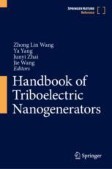Search
Search Results
-
Facile Fabrication of Flame-retardant SiO2/APP@PDMS Fabric with Superhydrophobicity for Highly Efficient Oil/Water Separation
Flame-retardant SiO 2 /APP@PDMS fabric with superhydrophobicity was prepared via ultrasound-assisted sol-gel method and dip-coatings, in which cotton...
-
Fluorine-free, robust and self-healing superhydrophobic cotton fabric based on the disulfide bond exchange reaction
Superhydrophobic (SH) surfaces are the surfaces with high static water contact angles (WCAs, > 150°) and low sliding angles (SAs, < 10°) which are...

-
Triboelectric Nanogenerators as Sensing for Smart Home
Smart home is one of the important components of future intelligent living systems, which involves automatic controlling, Internet of Things,...
-
Triboelectric Nanogenerators as Sensing for Smart Home
Smart home is one of the important components of future intelligent living systems, which involves automatic controlling, Internet of Things,...
-
Structured Surfaces with Engineered Wettability: Fundamentals, Industrial Applications, and Challenges for Commercialization
Wettability is a fundamental property used to determine solid-liquid interactions and plays an important role in develo** functional materials and...
-
Design and Fabrication of Wearable Biosensors: Materials, Methods, and Prospects
“Objects and their manufacture are inseparable. You understand a product if you understand how it’s made.” – Jonathan Ive.
-
Emerging Technological Applications of Additive Manufacturing
Once considered to be a field specific to mechanical sciences, additive manufacturing has now proliferated into all streams of science and swiftly...
-
Impact of pH and Calcination Temperature on Synthesis, Characterization, and Cytotoxicity of Silicon Oxide Nanoparticles
Silicon nanoparticles are critical in nanotechnology research. They are widely regarded as harmless and biocompatible. Silicon nanoparticles have...

-
Advanced Chemical Applications of Modified Cotton
Lightweight and flexible electronics are gaining popularity, especially in wearable technologies, because they allow a safe, healthy, and comfortable...
-
Chromogenic Materials
Chromic materials on the surface of any materials are a focus of interest of the entire customer in the market nowadays. This chapter describes the...
-
Multifunctional Sol-Gel Nanocomposite Coatings for Aerospace, Energy, and Strategic Applications: Challenges and Perspectives
Sol-gel technique is a wet chemical synthesis procedure involving the hydrolysis of either a fully hydrolyzable metal/silicon alkoxide or an...
-
Improving Flame Retardancy of Pineapple Leaf Fibers
Pineapple leaf fibers (PALF) are very suitable to act as reinforcing composite matrixes. Nevertheless, PALF is highly susceptible to the risk of fire...
-
Facile fabrication of superhydrophobic and flame-retardant coatings on cotton fabrics via layer-by-layer assembly
The hydrophilicity and intrinsic inflammability of pristine cotton fabrics severely restrict their applications. To overcome these disadvantages, a...

-
Application of Nanoparticles for Self-Cleaning Surfaces
Self-cleaning in one of the most significant applications in the recent years to repel the contaminants like dirt, toxic pollutants, and microbes...
-
Nanoparticles-Based Flexible Wearable Sensors for Health Monitoring Applications
The chapter presents some of the significant research done on the utilization of nanoparticles to fabricate and implement flexible wearable sensors...
-
Microfluidic Paper-Based Analytical Devices for Point-of-Care Diagnosis
Point-of-care testing (POCT) shows its significant importance in academic and social affairs (Jansen et al. 1998; Wu et al. 1999). From...
-
Wearable Optical Sensors
The market for wearable sensors is predicted to grow to $5.5 billion by 2025, impacting global health in unprecedented ways. Optics and photonics...
-
Recent progress on nanostructured conducting polymers and composites: synthesis, application and future aspects
Conducting polymers (CPs) have been widely investigated due to their extraordinary advantages over the traditional materials, including wide and...
-
Plasma Surface Modification of Biomaterials for Biomedical Applications
Application oriented selection of a material depends on the bulk properties of that material. However, a first encountering feature of any material...
